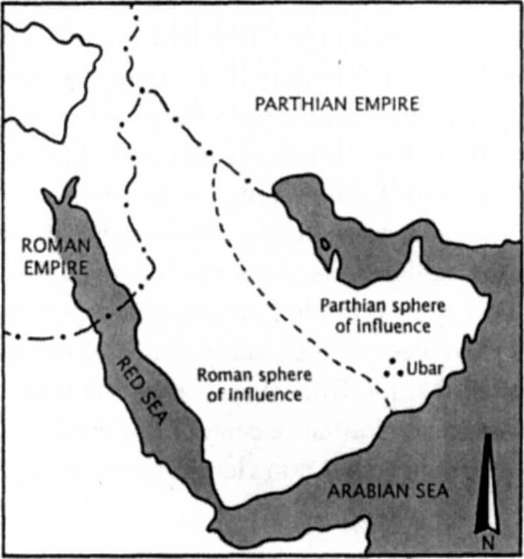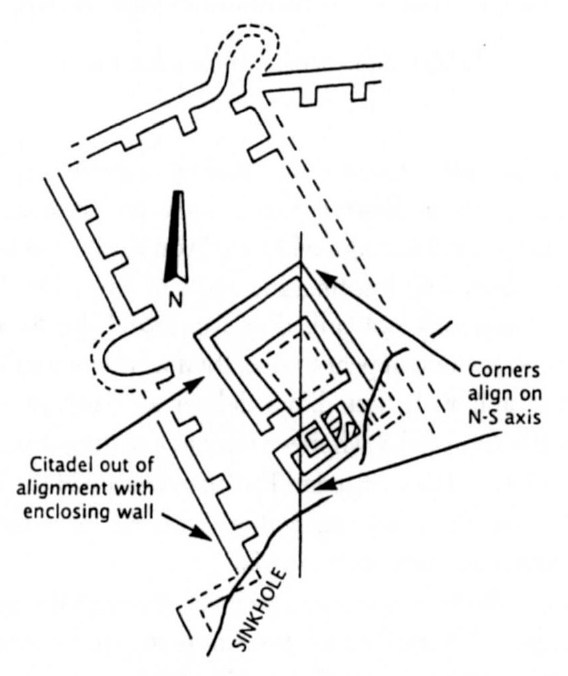Authors: Nicholas Clapp
The Road to Ubar (27 page)
It was time now to head home. Ran and the film crew, Kevin O'Brien and George Ollen, were to fly out of the coastal town of Salalah. Kay and I would drive overland to rendezvous with them in Muscat. We packed our Discovery with equipment on loan from our Omani sponsors or to be shipped back to the United States. We said goodbye to Juri and his students; we thanked Baheet, Mabrook, and the people of Shisur. We would leave at first light the next morning.
After breakfasting with Mr. Gomez, Kay and I stepped out into Shisur's dusty main street ... and were startled to find it lined by all our Rashidi friends. They had turned out to see us off and wish us well. We shook their hands, gave them hugs, then waved and wiped tears from our eyes as we drove away. Following the route of the March of Archaeology, we skirted ruined Ubar, then picked up a desert track heading east. "We'll be back, I'm sure we will," Kay said. "But it can never be the same, you know?" She quietly cried all the way to the oil camp at Dawqah, where we turned onto the paved road to Muscat.
J
URI AND HIS STUDENTS
stayed on at Shisur for another month. They confirmed that people had dwelt here long before Ubar's hilltop fortress had been built, not just in the area of its spring but in the surrounding countryside as well. Juri spent considerable time mapping a satellite site he called "Flintknapper's Village." It was Neolithicâas old as 6000
B.C.â
and he had a hunch that it had something to do with the beginnings of the People of'Ad. He wanted to work out a sequence of settlement for the area, but that would have to be a project for the future, for it was getting hot on the edge of the Rub' al-Khali. By noon every day, the Arabian sun pushed temperatures well into the triple digits.
In early March, Juri and his students left Ubar to the watchful eyes of Baheet and Mabrook and retreated to the coast. There, almost immediately, he discovered that Ubar had a sister city: Ain Humran, a fortress overlooking the Arabian Sea. We had briefly visited Ain Humran during our reconnaissance back in 1989. It was a gloomy place on top of a gloomy hill, a heap of broken black masonry. "An old Portuguese fort," we had been told back then, a remnant of the swath cut through this part of the world by Afonso de Albuquerque in the 1480s. But now Juri saw that Ain Humran's walls and towers were much like Ubar's in width, height, arrow slots, and overall configuration. Like Ubar, the site controlled access to a nearby water source. Ain Humran, in fact, means "Red Springs."

Ubar and Ain Humran: comparative site plans
The antiquity of the site was clinched as Juri and his students unearthed shards of dot-and-circle pottery, the now recognizable hallmark of the People of'Ad. Here at last was a major coastal settlement built by the builders of Ubar.
With a city on the coast and another inland, the People of 'Ad could have dispatched their frankincense to faraway markets by either land or sea. Each route had its hazards. Ships were prey to storms and pirates; caravans were subject to high tolls and the depredations of brigands. Each year the 'Ad could have chosen the most promising path or could have used both routes. And if Ubar was "Omanum Emporium" on Ptolemy's map of Arabia, Ain Humran was most likely the same map's "Zaphar Metropolis," the "major city of Dhofar."
In late April, with hardly a riyal to spare, Juri and his students headed back to the United States. On the eve of his departure, the Sultanate of Oman promised to underwrite, for three years, the excavation of both Ubar and Ain Humran. In those years Juri would also record over 270 major and minor sites on the coast, in the Dhofar Mountains, and in the desert. They all had one thing in common: they defined in time and space the world of the ancient, no longer mythical, People of'Ad.
1993: Season two at Ubar and Ain Humran.
At Ubar, the next year was the season of the Citadel.
Juri put his students and the Airwork volunteers to work clearing away the structure's rubble and sorting out its chronology. Its earliest phase dated to about 900
B.C.,
when it would have been the focus of a growing community that Juri called "Old Town." In approximately 350
B.C.
it was enlarged, and walls and towers were added to create "New Town," in which the Citadel hovered over an enclosed marketplace.
For the next six hundred years Ubar enjoyed the glory days of the incense trade. Its prosperity was mirrored in its finely crafted potteryâwhich, surprisingly, proved to be influenced more by the ancient cultures of the East than by those of the West. Though there was Greek and Roman ware here, much of Ubar's foreign (or foreign-inspired) pottery turned out to be Red Polished Indian Ware, a style indicative of a Mesopotamian/Persian influence.
1
In particular, Ubar seems to have had very strong ties to Parthia, a not very well known civilization that thrived between 400
B.C.
and 300
A.D.
and, in Juris words, "gave the Romans fits" as their rivals to the east.
Descendants of nomadic horsemen, the Parthians were a prag matic lot, with little interest in philosophy and the arts. They preferred baggy pants to flowing togas. They traded widelyâfrom China to Italyâand introduced to the West features of knighthood and chivalry, including jousting and coats of arms. On the field of battle, they frequently outflanked and outfoxed the Romans. The Parthian cavalry would appear to flee, then its riders would swivel in their saddles and with their bows deliver a "Parthian shot." The expression is with us today when we refer to a parting shot.

Foreign influences in Arabia, 200
B.C.
Juri hypothesized that a Roman-Parthian division of the Mediterranean world and the adjoining Fertile Crescent extended to client states in eastern versus western Arabia.
2
As his team shoveled and sifted their way through the passageways and chambers of Ubar's Citadel, Juri was pretty sure he was unearthing an administrative center that could also have been a defensive refuge in case of attack. But then there was the curious fact that the Citadel was built out of alignment with Ubar's nearby walls.
At the time, back in Los Angeles, I was intrigued by this anomaly and looked for parallels elsewhere in the Middle East, faxing Juri what I found. Some three hundred miles west of Ubar, the British archaeologist Gertrude Caton-Thompson had excavated the "Moon Temple" of Hureidha back in 1939. Noting that its corners were aligned with the cardinal directions, she theorized that its builders had been following the prevailing layout of Mesopotamian temples. Ubar's Citadel had precisely the same alignment (see below).

The Citadel at Ubar
So it appeared that the Citadel was, in part at least, a temple or shrine as well as an administrative center.
3
The ancient Arabians saw no reason to keep their gods at arm's length from mammon. The gods blessed commerce, and commerce handsomely paid them back. The moneychangers weren't in the temple by accident; they were there by design.
As they excavated the Citadel, Juris team cleared a passageway that led to a deep, finely plastered basin that once may have served a ritual function; perhaps it held water for ablutions, or possibly it was a place for the storage of temple frankincense. The passage turned to the left, then right, and ascended a well-constructed staircaseâthat ended in midair. Any chambers beyondâand the secrets they heldâhad sheared off and plunged into the site's sinkhole. The complete layout of the Citadel, unfortunately, would never be known.
Sometime after Ubar's great cataclysm, the Citadel and adjoining structures were partially reinhabited. In Tower #0 (so designated because it had been missed in the first season), Juris team excavated 72 centimeters of stratigraphic deposits. (It was, he said, a "Sedimental Journey.") From 900
A.D.
onward, the site had been rebuilt a half-dozen times, but with coarse mud brick rather than cut stone and fine plaster. As Juri commented, "Looks as if squatters moved in and hung out across from where the major collapse took place. Got by with as little as they could to make the place livable."
In early April of 1992, Juri shifted his crew to the coast, as he had the year before, and worked on through August. Kay and I joined him for a stint at Ain Humran. Kay, who had an eye for "surface collection," prowled the surrounding plain picking up bits and pieces of evidence of a sprawling agricultural community. I dug square #770 and didn't come up with an awful lot. When it came time for us to leave, I apologetically left the square to Juris wife, Sandy, who along with their kids was in Oman for the summer. Volunteer Ian Brown also worked the square and, six days after we left, was startled to unearth a vessel flecked with purple paint and marked with six crosses. A Christian chalice!
This was a significant find, for where there was a chalice, there was almost certainly a church, perhaps a monastery. The chalice raised the possibility of monks sailing to this remote comer of Arabia and establishing an outpost of Christianity in an abandoned incense-trading center. Significantly, they would have been dwelling in the shadow of "the eastern mountain range" of Genesis, biblical mountains marking the edge of the known world.

Chalice found at Ain Humran
There was once a considerable Christian presence in Arabia, and though documentation is sparse, there is a chance that Ain Humran was the missing "third church" founded by the Byzantine missionary Theophilus Indus in the middle 300s. The sites of Theophilus's first and second churches are known; the only clue to the locale of the third is that it was at a coastal emporium east of ancient Aden. It could well have been Ain Humran.
Theophilus, incidentally, was renowned for his DeMille-like miracles. A skeptical Arabian throng once challenged him: "Show us our Christ, alas!" The customary answer to this is an apologetic and gentle explanation that God works in mysterious ways and cannot be expected to work miracles on demand. Not in this case. Theophilus delivered. He looked skyward, "whereupon, after a terrible storm of thunder and lightning, Jesus Christ appeared in the air, surrounded with rays of glory, walking on a purple cloud, having a sword in his hand and an inestimable diadem on his head ... [The challengers] were stricken blind, and recovered not till they were all baptized."
4